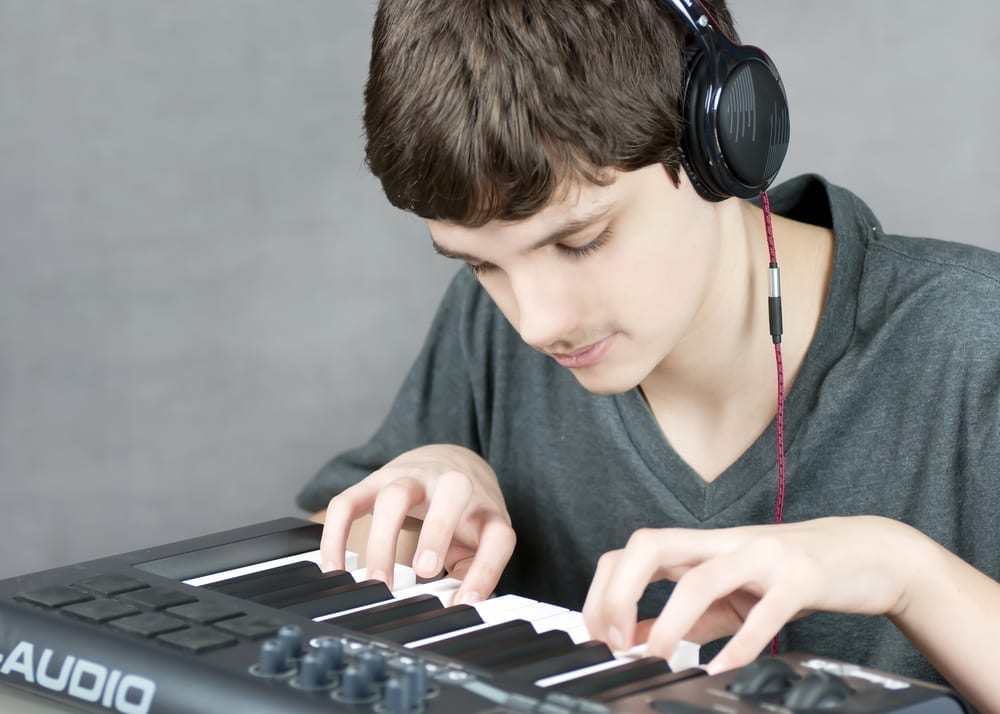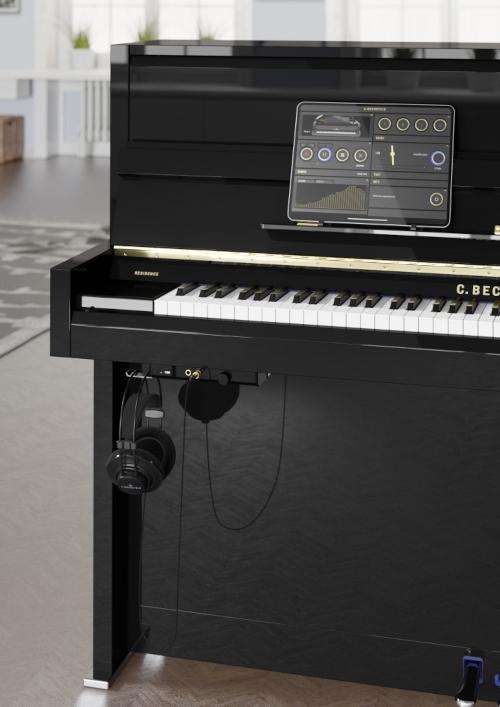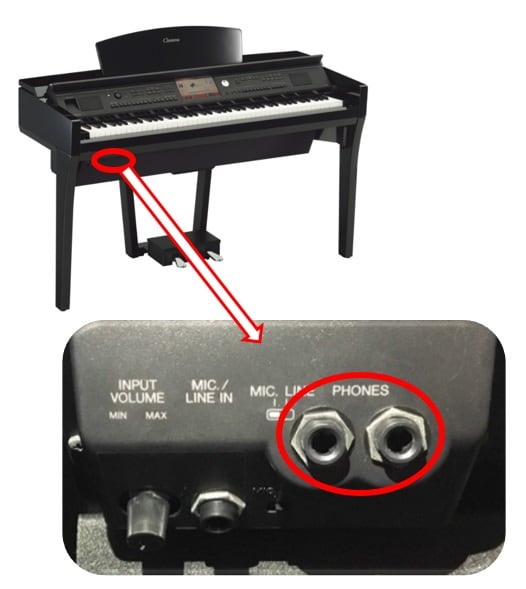Yes, many modern pianos can have a headphone jack. This feature allows for silent practice.
Playing the piano without disturbing others is now possible thanks to the integration of headphone jacks in digital and some acoustic pianos with silent systems. For beginners and professionals alike, the addition of headphone capabilities has transformed the way people practice and enjoy music.
It ensures privacy and eliminates the barrier of noise restrictions, which can be particularly beneficial in apartments or late at night. Digital pianos with built-in headphone jacks have made this feature commonplace, allowing players to immerse themselves in their music without external interference. Even certain traditional acoustic pianos can be retrofitted with silent systems, blending the authentic touch of a classic instrument with the modern convenience of headphones. This shift has opened up new possibilities for pianists to hone their craft at any hour without compromising the peace of their surroundings.

Credit: www.pianoforte.com.au
The Quiet Revolution In Piano Practice
The Quiet Revolution in Piano Practice marks a significant leap in how pianists hone their craft. Imagine immersing yourself in music without disturbing others. This dream is now a reality with pianos equipped for silent play. Through headphones, players explore new dimensions of sound and tranquility. Let’s delve into why this silent feature is becoming a staple for piano enthusiasts.
Why Pianists Desire Silent Practice
- Distraction-Free Environment: Headphones shield pianists from outside noise, allowing total focus.
- Night Owl Sessions: Whether at dawn or dusk, players practice without time constraints.
- Family Harmony: Housemates appreciate the quiet, promoting a peaceful coexistence.
- Personalized Sound: Players adjust volume and effects to suit personal preferences.
Evolution Of Piano Sound Control
From mechanical muting devices to digital innovation, pianos have evolved. This table highlights key milestones in piano sound control.
| Era | Advancement |
|---|---|
| Early 20th Century | Felt muting strips |
| 1970s | First electronic keyboards |
| 1980s | MIDI technology |
| 2000s | Advancements in digital sampling |
| Today | Hybrid silent systems |
Pianos have transformed from mere acoustic instruments to sophisticated sound systems. This allows silent practice without losing the touch of traditional pianos. Musicians embrace this blend of old and new, perfecting their music for the world to hear—or not!

Credit: pianopricepoint.com
Breaking Down The Piano’s Traditional Limits
Pianos have long filled homes and concert halls with beautiful music. There once was a time when playing the piano meant sharing the melody with everyone nearby. Yet, those days are changing. Modern technology offers pianists the choice to play privately using headphones. This feature takes the piano beyond its traditional bounds. It combines the joy of music with the respect for quiet space.
Acoustic Vs. Digital Pianos
Understanding the difference between acoustic and digital pianos is key. It shapes a pianist’s practice and performance. Acoustic pianos create sound through hammers hitting strings. This process is purely mechanical. It results from years of skilled craftsmanship. In contrast, digital pianos use electronic means to produce sound. This often includes the option to plug in headphones.
Acoustic Pianos:
- Natural, rich sound
- Hammer-and-string dynamics
- Heavier touch response
Digital Pianos:
- Varied sound options
- Headphone compatibility
- Lightweight and portable
Blending Time-honored Resonance With Modern Silence
The classic resonance of pianos has always been cherished. Yet, the need for silence during late-night practices or in shared spaces cannot be ignored. Digital pianos offer a solution. They maintain the traditional piano feel while allowing for silent play. Headphones enable pianists to immerse in their music without disturbing others.
The integration of headphone accessibility in digital pianos is a game-changer. It offers:
- Privacy during practice
- Freedom to play at any hour
- No compromise on sound quality
This feature allows everyone to enjoy playing or listening to piano music in their own way. It respects individual needs for peace and quiet.
How Headphone Technology Enhances Private Play
Headphone technology transforms piano practice into an intimate experience. It allows pianists to immerse themselves in music without external distractions. With headphones, players can focus deeply, perfecting melodies and harmonies. This technology brings forth a blend of convenience and privacy. Musicians of all levels can practice at any hour without disturbing others.
Integration With Acoustic Instruments
Even traditional pianos now embrace headphone technology. Many acoustic pianos come equipped with silent systems. These systems enable a ‘mute’ function where the hammers do not strike the strings. Instead, the piano’s sounds are digital and directed through headphones. This innovation allows for uninterrupted practice while maintaining the feel of an acoustic keyboard.
- Acoustic touch: Maintains the mechanical feel
- Digitized sound: Ensures clear audio output
- Volume control: Allows for sound level adjustments
Specialized Headphones For Digital Pianos
Digital pianos offer a built-in headphone experience. These instruments come with dedicated headphone outputs. With specialized headphones, players enjoy high-quality sounds. These headphones are optimized to reproduce the piano’s dynamic range. Musicians can hear every nuance of their play.
| Feature | Benefit |
|---|---|
| Noise-canceling abilities | Reduces external noise |
| Comfortable ear padding | Enables long sessions |
| Wide frequency range | Captures all piano sounds |
By using these specialized headphones, pianists experience a true-to-life sound akin to a live performance. Play with confidence that every keystroke is heard with clarity and depth.
The Mechanics Behind Soundless Keyboards
The magic of modern pianos marries digital technology with traditional acoustic charm. Soundless keyboards, also known as silent pianos, enable pianists to enjoy their instruments without disturbing others. This feat is possible through an ingenious fusion of mechanics and electronics.
Silent Piano Systems Explained
Silent piano systems work by halting the hammers in a piano from striking the strings. Instead, sensors detect keystrokes and send this information to a digital sound module. This module then produces the piano’s tone through headphones. This allows for silent practice without any sound broadcasting into the room.
Converting Acoustic Vibrations To Digital Signals
The technology behind this system is both simple and intricate. It has two key parts:
- Sensor bar: Detects keystrokes.
- Sound module: Transforms keystrokes into sound.
When activated, the middle pedal on a piano with a silent system engages an optical or mechanical sensor. This sensor reads the movement of keys and hammers. It then translates that movement into digital data.
The sound module, often containing high-quality sampled piano sounds, receives this data. It produces the corresponding notes through headphones or a speaker system.
This system provides an authentic feel to the pianist while remaining virtually silent to others.
Stepping Into The Future With Hybrid Pianos
Imagine playing a grand piano in silence to others, but in full harmony to you. Hybrid pianos make this possible. They blend the beauty of acoustic pianos with digital innovation. With headphones, you can immerse yourself in music without disturbing a soul. Let’s explore the remarkable features of these future-forward instruments.
Marrying Tradition With Technology
Hybrid pianos stand at the crossroads of history and modernity. Crafted with the soul of a traditional piano, they boast digital versatility. You get the touch of real ivory keys and the tone of magnificent strings. But you also enjoy the liberty to plug in headphones and play anytime. The sound is rich and personal, delivered straight to your ears.
- Acoustic piano design
- Digital sound precision
- Headphone compatibility for silent practice
The Hybrid Revolution
Hybrid pianos are game-changers.
- They protect your privacy and peace.
- These instruments offer a variety of digital sounds.
- Recording and sharing music becomes effortless.
The headphone feature invites players of all levels to delve into music, day or night. It’s an experience that feels both classic and contemporary.
Choosing The Right Equipment For You
Imagine playing piano without disturbing others. Headphones make this possible. Choosing the right equipment for you transforms the experience. This guide helps find perfect headphones for your piano.
Criteria For Selecting Headphones
Sound quality tops the list. Look for clear, rich audio that brings notes to life. Comfort comes next. You need lightweight, padded headphones for long sessions. Consider durability. Sturdy headphones withstand daily use. Connectivity matters too. Choose between wired or wireless options. Price should align with your budget.
- Clear and rich sound
- Comfortable padding and fit
- Sturdy build for durability
- Choice of wired or wireless
- Budget-friendly options
Matching Headphones With Piano Type
Digital pianos often have a standard headphone jack. Match headphones to this. Check for compatibility. Acoustic pianos need a separate device, like a QuietTime system.
| Piano Type | Headphone Feature |
|---|---|
| Digital | Standard jack, Direct plug-in |
| Acoustic | Needs separate device |

Credit: ca.yamaha.com
Can I Connect Headphones to a Piano to Listen to the Music?
Yes, you can connect headphones to a digital piano to hear the music piano without disturbing anyone else. Most digital pianos have a headphone jack that allows you to listen to your playing privately. This is especially useful for late-night practice sessions or for musicians living in shared spaces.
Frequently Asked Questions Of Can Pianos Have A Headphone
Can You Use Headphones On A Piano?
Yes, you can use headphones with a piano. Digital pianos often have headphone jacks for private practice.
Do Yamaha Pianos Have Headphone Jacks?
Many Yamaha pianos, particularly digital and silent models, feature built-in headphone jacks for private practice.
Can I Use Gaming Headphones For Piano?
Yes, you can use gaming headphones for playing piano as they often offer high-quality sound and comfort. Just ensure they’re compatible with your piano’s audio output.
Does Piano Have Bluetooth?
Some modern pianos come equipped with Bluetooth functionality, allowing wireless connection to devices for various features like music streaming and app integration.
Conclusion
As we’ve seen, pianos with headphone capabilities offer substantial benefits. They provide privacy, flexibility, and the freedom to play anytime. These features make them a great fit for modern living spaces and busy lifestyles. Whether you’re a budding musician or an experienced pianist, adding headphones can transform your practice sessions into an intimate musical journey.
{ “@context”: “https://schema.org”, “@type”: “FAQPage”, “mainEntity”: [ { “@type”: “Question”, “name”: “Can you use headphones on a piano?”, “acceptedAnswer”: { “@type”: “Answer”, “text”: “Yes, you can use headphones with a piano. Digital pianos often have headphone jacks for private practice.” } } , { “@type”: “Question”, “name”: “Do Yamaha pianos have headphone jacks?”, “acceptedAnswer”: { “@type”: “Answer”, “text”: “Many Yamaha pianos, particularly digital and silent models, feature built-in headphone jacks for private practice.” } } , { “@type”: “Question”, “name”: “Can I use gaming headphones for piano?”, “acceptedAnswer”: { “@type”: “Answer”, “text”: “Yes, you can use gaming headphones for playing piano as they often offer high-quality sound and comfort. Just ensure they’re compatible with your piano’s audio output.” } } , { “@type”: “Question”, “name”: “Does piano have Bluetooth?”, “acceptedAnswer”: { “@type”: “Answer”, “text”: “Some modern pianos come equipped with Bluetooth functionality, allowing wireless connection to devices for various features like music streaming and app integration.” } } ] }
